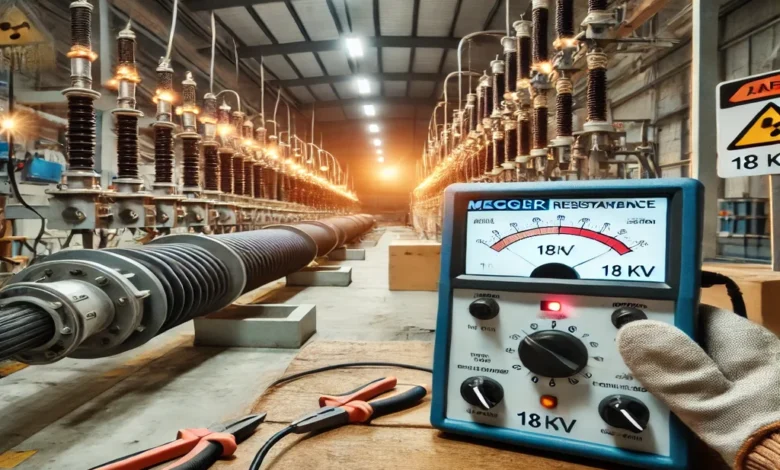Con Cuánto se Mega un Cable de 18 kV: A Comprehensive Guide

Megger testing, or insulation resistance testing, is a crucial procedure to ensure the reliability and safety of medium-voltage cables, including 18 kV cables. This test helps detect insulation weaknesses, moisture ingress, and degradation that could lead to electrical failures. The question “Con cuánto se mega un cable de 18 kV?” refers to the voltage level required for a proper insulation resistance test.
In this article, we will explore the principles of megger testing, recommended test voltages, industry standards, procedures, and best practices for testing an 18 kV cable.
What is Megger Testing?
Megger testing measures the insulation resistance of electrical cables and equipment using a high-voltage DC source. It helps identify potential insulation faults before they lead to operational failures or hazardous conditions.
This test is essential for:
- New cable installations to verify insulation integrity.
- Periodic maintenance to assess aging and wear.
- Fault diagnosis to detect insulation breakdown.
How to Determine the Correct Megger Test Voltage for an 18 kV Cable
The recommended test voltage for an 18 kV cable depends on various standards, including:
- IEEE 400.1 – Field Testing of Shielded Power Cables
- IEC 60502-2 – Power Cables with Extruded Insulation
- NEMA WC 74 / ICEA S-93-639 – Standard for Shielded Power Cables
Recommended Megger Test Voltages for an 18 kV Cable
| Cable Rated Voltage | DC Test Voltage (New Cables) | DC Test Voltage (Maintenance) |
|---|---|---|
| 18 kV | 36 kV – 45 kV | 18 kV – 22.5 kV |
- New cables typically undergo a DC test at 2 to 2.5 times their rated voltage.
- Aged cables (in service for years) should be tested at around 1 to 1.25 times their rated voltage to prevent insulation damage.
Important Consideration: Some experts advise against high-voltage DC testing for aged XLPE-insulated cables, as it can induce electrical treeing and insulation degradation. Instead, Very Low Frequency (VLF) AC testing is recommended.
Also Read: Plaza de Godoy Cruz Theater Accident: A Detailed Account of the Tragedy
Step-by-Step Procedure for Megger Testing an 18 kV Cable
1. Safety Precautions
Before performing a megger test, ensure:
- The cable is de-energized and properly grounded.
- Personal protective equipment (PPE) is worn.
- The testing area is clear of unauthorized personnel.
2. Preparing the Cable for Testing
- Disconnect the cable from any connected equipment.
- Clean and dry the cable terminations.
- Ensure environmental conditions (humidity, temperature) are stable.
3. Selecting the Test Voltage
Refer to the recommended voltage table above to determine the correct DC test voltage.
4. Conducting the Insulation Resistance Test
- Connect the megger tester leads:
- Positive (HV) lead to the conductor.
- Negative (earth) lead to the cable shield or ground.
- Apply the test voltage gradually and hold it for 1 minute.
- Record the insulation resistance (measured in Megaohms, MΩ).
5. Analyzing the Results
| Insulation Resistance (MΩ) | Interpretation |
|---|---|
| > 100 MΩ | Excellent |
| 10 – 100 MΩ | Good |
| 1 – 10 MΩ | Fair |
| < 1 MΩ | Poor – Possible Fault |
If the insulation resistance is too low, the cable may have moisture ingress, contamination, or insulation breakdown. Further diagnostic testing (e.g., Tan Delta or Partial Discharge testing) may be required.
Factors Affecting Megger Test Results
1. Cable Length
Longer cables exhibit lower insulation resistance due to increased capacitance. Always normalize results based on cable length.
2. Temperature & Humidity
Higher temperatures reduce insulation resistance. Industry standards typically reference 20°C as the base temperature for comparisons.
3. Cable Insulation Type
Different insulation materials (e.g., XLPE, EPR, PILC) have varying resistance characteristics. Always refer to manufacturer specifications.
Alternative Testing Methods for 18 kV Cables
While DC megger testing is common, alternative methods include:
- Very Low Frequency (VLF) Testing
- Uses AC voltage at 0.1 Hz for non-destructive testing of aged cables.
- Recommended for XLPE and EPR cables to prevent insulation stress.
- Tan Delta Testing
- Measures insulation degradation over time.
- Helps predict failures before they occur.
- Partial Discharge (PD) Testing
- Detects microscopic insulation breakdowns before they become critical faults.
- Commonly used in underground cables and high-voltage networks.
Best Practices for Megger Testing 18 kV Cables
- Follow Manufacturer & Industry Standards: Always adhere to IEEE, IEC, and NEMA guidelines.
- Avoid Over-Testing: Repeated high-voltage DC tests can accelerate insulation degradation.
- Perform Routine Testing: Periodic testing helps detect degradation before failures occur.
- Use Trending Analysis: Compare historical test data to identify gradual insulation deterioration.
Conclusion
The question Con cuánto se mega un cable de 18 kV? s crucial for ensuring the reliability of medium-voltage cables. The standard practice is to apply 36 kV to 45 kV for new cables and 18 kV to 22.5 kV for in-service cables.
Also Read: Understanding the Mystery Behind the Number 970616839: Scam or Legitimate?
Proper megger testing helps detect insulation faults early, preventing costly failures and ensuring system safety. However, it is essential to follow best practices, consider alternative test methods for aged cables, and analyze test results correctly to maintain optimal cable performance.




